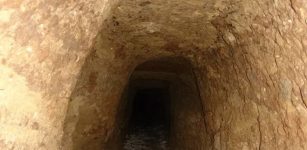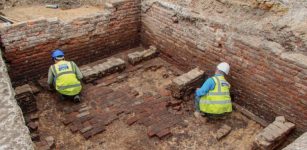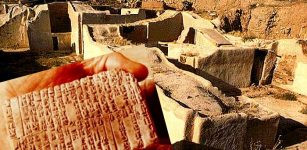3,000-Year-Old Bakery With Large Amounts Of Flour Discovered In Armenia
Jan Bartek - AncientPages.com - Archaeologists excavating in Armenia have discovered ruins of a 3,000-year-old bakery.
A Polish-American archaeology team made the find in Metsamor, where the researchers came across a large building supported on columns, which collapsed during a fire. At the site, scientists noticed a substance that initially looked like ashes.
Inside this building, archaeologists discovered large amounts of flour. Photo: Patrick Okrajek
Scientists knew that the substance was organic and gathered roughly four to five sacks filled with the substance. A performed chemical analysis of the substance revealed it to be ancient wheat flour remnants. Then, the research team realized this ancient building had once been a bakery.
The research in Metsamor is a joint project of the Faculty of Archeology of the University of Warsaw, the Center of Mediterranean Archeology of the University of Warsaw, and the Department of Antiquities and Protection of National Heritage of Armenia. On the Armenian side, the project is headed by Professor Ashot Piliposian.
Professor Jakubiak admitted that the unearthed flour "is not good for anything." now. According to the researchers' estimates, up to 3.5 tons of flour were originally collected in this ancient structure.
The structure spans 82 by 82 feet, and it is evident it was once a huge bakery used from the latter part of 1100 B.C. until the start of 900 B.C.
Aerial view of Metsamor. In the lower part of the photo are the walls surrounding the fortress. Above them, in the so-called In lower town, a trench is visible where a building with a colonnade filled with flour was discovered. Photo: Patrick Okrajek
According to Science in Poland, the structure had a representative function initially, and then its interior was changed. It was probably intended for economic purposes because several furnaces were added. There was flour next to them. Most likely, it was wheat flour used to bake bread. From the amount of preserved material, it can be concluded that the production was truly mass production, scientists say.
See also: More Archaeology News
The ancient bakery consisted of two rows of a total of 18 wooden columns supporting a reed roof with wooden beams. Only the stone bases of the columns and well-preserved burned fragments of beams and roof sheathing have survived to our times.
"It is one of the oldest known structures of this type from the southern Caucasus and eastern Anatolia. Its remains have been preserved so well only thanks to an ancient fire that put an end to this building," Professor Jacob said.
Written by Jan Bartek – AncientPages.com Staff






















